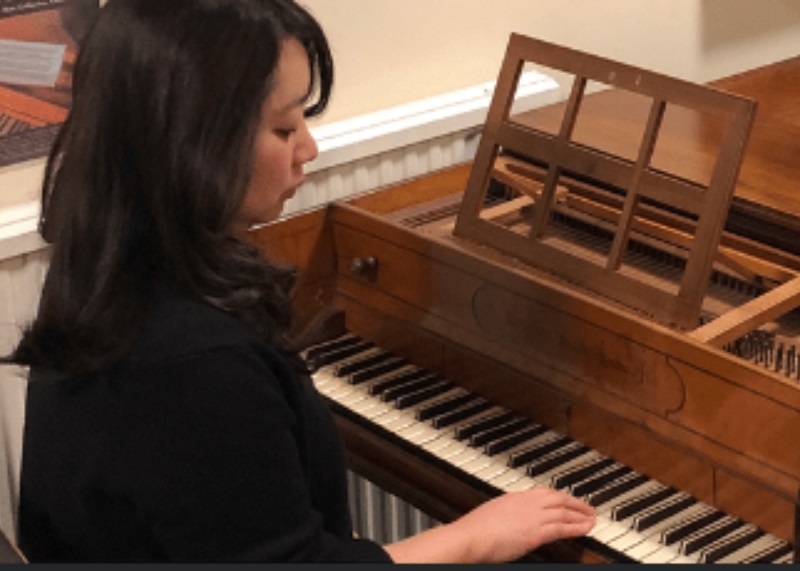Akutagawa pairs familiar and obscure in Teutonic-themed Capriccio recital

Naoko Akutagawa performed Thursday night at St. Thomas’ Parish in Dupont Circle.
Capriccio Baroque, an early music niche within the larger niche of classical music, opened its new season Thursday night. An intentionally small audience, the hallmark of this boutique concert series, heard a program of harpsichord music from German-speaking lands performed by Naoko Akutagawa. The venue was St. Thomas’ Parish in Dupont Circle, which has begun hosting such events in its newly rebuilt, modernist sanctuary.
The Japanese-born harpsichordist played a first half devoted to little-heard music by a father and son pairing, Georg Muffat and Gottlieb Muffat. Georg’s Partita in C Major revealed the elder composer’s fluency in dance rhythms. Akutagawa rendered the piece in a four-square manner but added pleasing embellishments on the repeats. Playing on a modern double-manual harpsichord, built by Colin Booth and owned by Capriccio’s executive director, Carolyn Winter, Akutagawa did not stray too far into the instrument’s extremes of registration.
The elder Muffat’s skill came through more colorfully in his Passacaglia in G Minor, a complex set of variations on a recurring bass pattern that wanders into some wild chromatic vagaries. A rondeau-like refrain, repeated periodically throughout, gave a sense of order to the unfolding elaboration of variations. Akutagawa’s hands moved with more confidence in this demanding piece, with especially even trills and flowing scalar passages.
Last year, Akutagawa completed a three-disk set of rediscovered music by Gottlieb Muffat, Georg’s son. The editor of this music, Glen Wilson, who is also married to Akutagawa, gave a concise and informative introduction to the program. The previously lost pieces were found in a library in Kyiv, taken there by the Soviet Army during World War II. The younger Muffat’s star rose when he began to work at the imperial court in Vienna, teaching the young noblewoman who later became Empress Maria Theresa and following her to fame.
Some of the eight movements in Gottlieb’s Keyboard Suite in A Major are shorter than a minute in duration. Akutagawa gave the Sarabande especially decorated embellishments when she repeated each section, followed by a jaunty Gavotte and an Air en Menuet movement lightened by a softer registration, adding some needed tonal variety. Again her most brilliant playing came in Gottlieb’s Chacona in G Major, numbered as Componimenti Musicali No. 7, a mammoth set of thirty-eight variations. A much greater use of registration shifts created subtle distinctions in the minor-mode section.
Akutagawa’s approach remained well-behaved more than daring in Johann Mattheson’s Suite No. 1, with a few minor missed notes in the Prelude. She used Mattheson’s “doubles,” written-out ornamentations of the Allemande and Courante, as the repeats of those movements. The extravagance of these embellishments guided her own more intricate ornamentation of the lovely Sarabande movement, in a nice touch. The contrapuntal Gigue, with its thematic motif inverted in the B section, was a stylish tour de force.
The program’s pattern alternating dance movements with variation sets was broken at this point, thanks to an inventive Toccata in A Major, attributed by Glen Wilson to Dieterich Buxtehude. Rapid figuration, contrapuntal imitation, and something like operatic recitative spun by in dizzying succession. The same composer’s poignant Aria and Variations in A Minor, similar in some ways to Bach’s much more extensive Goldberg Variations, provided a needed respite for reflection.
Every piece heard up to this point was eclipsed by Handel’s Keyboard Suite No. 5, a comparison that illustrates the difference between goodness and greatness. (Handel, known to cannibalize the music of other composers, borrowed from Gottlieb Muffat at times, and vice-versa.) The strength of Handel’s score drew out some of Akutagawa’s best playing, too, with rhythmic freedom in the Prelude and polished calm in the dance movements.
This celebrated suite concludes not with a gigue, but with another air and variations, later given the evocative title of “The Harmonious Blacksmith.” Akutagawa easily tamed the increasingly thorny variations, with running patterns in eighth notes and then triplets flowing through the right hand and then the left hand. A few hiccups appeared in the final, most difficult variation, but the overall effect was striking and admirable. The harpsichordist added two elegant encores, the stately Passacaglia in G Minor by Handel and, to end the evening serenely, Buxtehude’s tender Sarabande in E Minor.
Harpsichordist Glen Wilson will perform a program of rarely heard music by Adrian Willaert 6:30 p.m. October 1. capricciobaroque.org
